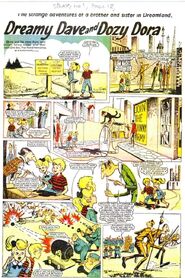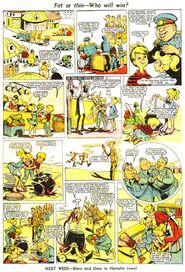

Dreamy Dave and Dozy Dora is one of the most whimsical of the 'nursery' strips that populated the early years of Sparky. The simple but effective premise of the central sleepy pair is that they fall into slumberland at the drop of a hat, and embark upon weird-and-wonderful misadventures reminiscent of those that befell Alice in Wonderland.
This dreamlike and disorientating, sometimes alarming (in its depiction of often frankly bizarre characters) concept would stand this strip in good stead right from issue one, through until very late 1968, during which time the format rarely swayed for the dreamland pair (amongst the most innocent and trusting duo seen in any comic of the era, another of its slightly disturbing properties) — they would encounter a single strange character from the subconscious, who would introduce them to a sometimes nightmare world of escalating insanity.
Another departure rarely seen in most comics of this type is that they age perceptibly over the strip's run. In early episodes Dave and Dora look about four or five, but they're kicking eight years old at least by the series' end! For some reason, the fantasy and illogicalities of their dream-world never granted them the advantages of eternal youth.
For all its strangeness, (or possibly because of this!) Dreamy Dave and Dozy Dora remains one of the handful of easily-remembered concepts of the very early period of Sparky, striking a chord even today to those who remember the early period of this least-revered of the stable of D.C. Thomson humour comics. Artists who worked on this strip at various times included James Malcolm and Pam Chapeau, the latter of whom was to turn out much similarly whimsical work on Mr Bubbles.
The strip was altogether strange and sometimes even sinister, but without a doubt one of the key elements that summed up the very early Sparky. This is perhaps partly due to the fact that it was often rendered in full colour, within the centre spread.


